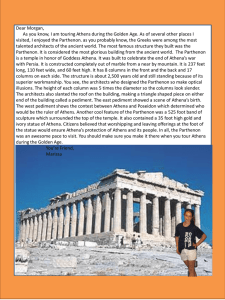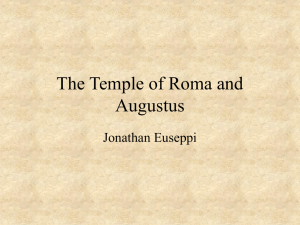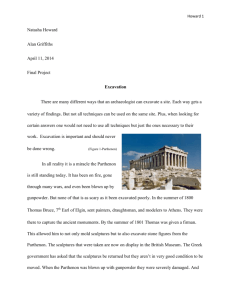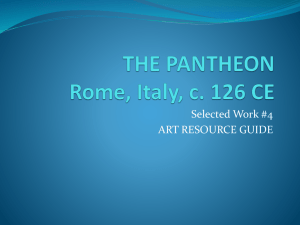Parthenon Structure Contrast
advertisement
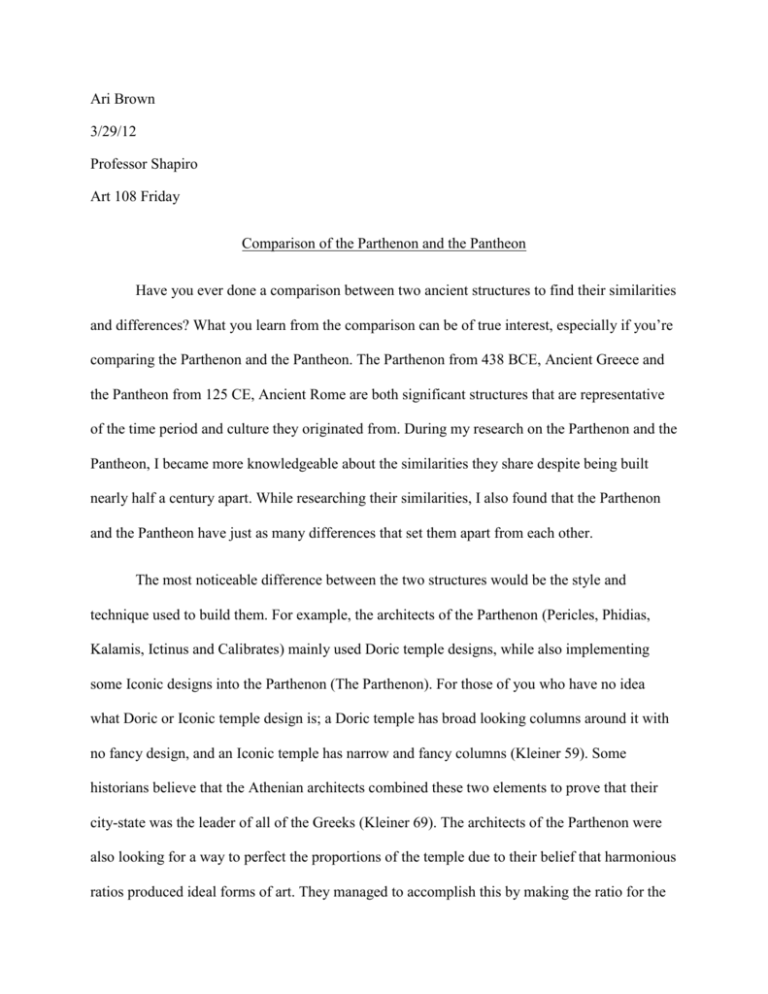
Ari Brown 3/29/12 Professor Shapiro Art 108 Friday Comparison of the Parthenon and the Pantheon Have you ever done a comparison between two ancient structures to find their similarities and differences? What you learn from the comparison can be of true interest, especially if you’re comparing the Parthenon and the Pantheon. The Parthenon from 438 BCE, Ancient Greece and the Pantheon from 125 CE, Ancient Rome are both significant structures that are representative of the time period and culture they originated from. During my research on the Parthenon and the Pantheon, I became more knowledgeable about the similarities they share despite being built nearly half a century apart. While researching their similarities, I also found that the Parthenon and the Pantheon have just as many differences that set them apart from each other. The most noticeable difference between the two structures would be the style and technique used to build them. For example, the architects of the Parthenon (Pericles, Phidias, Kalamis, Ictinus and Calibrates) mainly used Doric temple designs, while also implementing some Iconic designs into the Parthenon (The Parthenon). For those of you who have no idea what Doric or Iconic temple design is; a Doric temple has broad looking columns around it with no fancy design, and an Iconic temple has narrow and fancy columns (Kleiner 59). Some historians believe that the Athenian architects combined these two elements to prove that their city-state was the leader of all of the Greeks (Kleiner 69). The architects of the Parthenon were also looking for a way to perfect the proportions of the temple due to their belief that harmonious ratios produced ideal forms of art. They managed to accomplish this by making the ratio for the pillars x=2y+1, or 17 by 8 columns for us none math wizards (Kleiner 69). To make the Parthenon temple look even more symmetrical than it really was, the architects used a created an optical illusion by making unique curvatures in the columns, stylobate, and the taper of the Naos walls (PBS). With all these techniques used in the Parthenon, it’s no surprise that it is one of the most famous structures that use post-and-lintel (a structure consisting of vertical beams supporting a horizontal beam) construction in the Ancient world. Moving on about a half a century ahead, the Roman architects used a completely different technique and style to build the Pantheon temple. The Romans were known for using concrete and internal support beams to construct their structures, rather than using marble and post-and-lintel building styles. These innovations in their architecture revolutionized building techniques by allowing them to build in ways post-and-lintel architects could not. The Pantheon is one of the most famous examples of a hemispherical dome (a round arch rotated around the circumference of a circle) (Kleiner 96). The Pantheon only has one opening and religious (and maybe some other) ceremonies were held inside the dome. The Parthenon on the other hand, had many openings so people could gather around the temple to see the goddess Athena’s statue, but they had their religious ceremonies on the outside. The dome structure is supported by several intersecting arches rather than columns (Pantheon). The columns seen on the outside of the Pantheon are merely decorative and hold no function in supporting the structures weight. The Romans were well aware of the weight of the construction materials they were using, so they used lighter materials toward the top of the dome to put less strain on the internal support beams (Roman Pantheon). The Romans also used sunken decorative panels known as coffers, to reduce the weight of the dome without weakening its materials. The circular opening on the roof is the oculus, which is the only light source on the inside of the Pantheon. Through the oculus, people are able to watch the sunlight move across the sky throughout the day. The Pantheon’s design was based on two intersecting circles so that the spacious interior of the dome would symbolize the Earth, while the dome itself represented the vault of the heavens (Kleiner 110). The experience art historians have had while looking at the Pantheon has been described as breathtaking, eye opening, and mystical. If you ever take a trip down to Rome, take a look at the Pantheon yourself and witness firsthand what makes this structure so significant to art historians. Despite these two ancient structures being built nearly half a century apart, they still shared some striking similarities with each other. For starters, both temples were built for religious purposes. The Parthenon was created in order to show gratitude to the goddess Athena for the Athens’s victory over the Persian invaders, as the Pantheon was created to honor all the Ancient Roman and Ancient Greeks gods and goddesses (Harris and Zucker). The front of the Pantheon temple also resembles traditional temples made in Ancient Greece. The decorative rows of Corinthian columns on the outside of the temple are similar to Iconic columns, except their capitals are decorated with acanthus leaves, foliage, or different flowers and have an upward flow that enhances the columns height (Types of Columns-Corinthian Columns). The Parthenon and the Pantheon also share a similar history, in which they were originally destroyed, but later rebuilt (Parthenon). To summarize, the Parthenon and the Pantheon are two magnificent structures that reflect the time period and culture they originated from. Though the two structures are similar in name, they are extremely different in the style and technique used to build them. The Parthenon uses post-and-lintel configuration and combines both Doric and Iconic architectural elements. The shape of the temple takes a more rectangular shape, similar to previous temples in Ancient Greece and uses a unique harmonious ratio and optical illusion to create a more symmetrical look in the temple. The Pantheon on the other hand, uses revolutionary building techniques discovered during the Ancient Roman civilization, which utilizes cement and internal support structures to their full potential. The Pantheon is a prime example of a hemispherical dome and is one of the most well preserved ancient structures to this very day. Its facade shows a traditional temple design, which masks the huge cylindrical structure behind it. Despite being many years apart, there are some similarities found between the two ancient structures such as their history, purpose, and most of all; their significance to art history and culture. Works Cited Kleiner, Fred S. Gardener's Art Through The Ages. Boston: Clark Baxter, 2009. Pantheon. 2011. 29 March 2012 <http://www.encyclopedia.com>. Parthenon. 2011. 29 March 2012 <http://www.encyclopedia.com>. Roman Pantheon. 28 March 2012 <http://www.rome.info>. Secrets of the Parthenon: Chapter 1 of 5: An Icon of Civilization. PBS. 2008. The Pantheon, Rome. Perf. Beth Harris and Steven Zucker. 2012. The Parthenon. 28 March 2012 <http://www.ancientgreece.com>. Types of Columns-Corinthian Columns. 2010. 28 March 2012 <http://www.guidetocolumns.com>.
